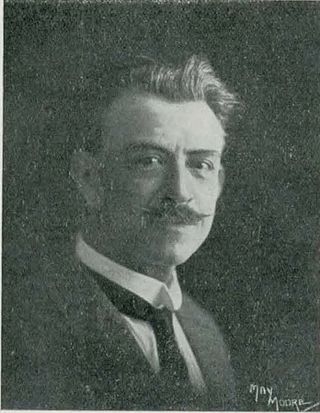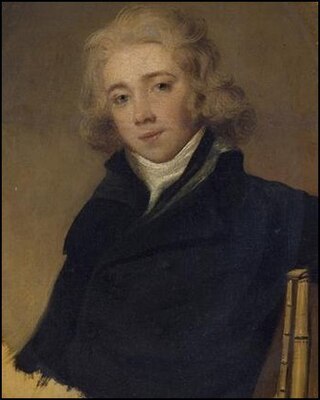Related Research Articles

Alfred Francis Hill CMG OBE was an Australian-New Zealand composer, conductor and teacher.

The String Octet in E-flat major, Op. 20, MWV R 20, was written by the 16-year-old Felix Mendelssohn during the fall of 1825 and completed on October 15. Written for four violins, two violas, and two cellos, this work created a new chamber music genre. Conrad Wilson summarizes much of its reception ever since: "Its youthful verve, brilliance and perfection make it one of the miracles of nineteenth-century music." This was one of the first works of Mendelssohn to be very well received.

Hyacinthe Jadin was a French composer who came from a musical family. His uncle Georges Jadin was a composer in Versailles and Paris, along with his father Jean Jadin, who had played bassoon for the French Royal Orchestra. He was one of five musical brothers, the best known of whom was Louis-Emmanuel Jadin.
String Quartet No. 1 in B-flat major "Maori Quartet", Stiles 1.2.3.3 SQ1 is the first of Alfred Hill's seventeen string quartets. Its composition began before 1892, it was completed after 1896 and premiered only on 18 May 1911 in Sydney.
Alfred Hill composed his String Quartet No. 3 in A minor "The Carnival", Stiles 1.2.3.3 SQ3, in 1912, while he was a member of the Austral String Quartet. The manuscript score is preserved in the National Library of Australia. In 1955, Hill transformed the quartet into his Symphony No. 5. The quartet is composed in four movements with an average duration of 20 minutes.
String Quartet No. 2 in G minor "A Maori Legend in Four Scenes", Stiles 1.2.3.3 SQ2, often called "Maori Quartet", was composed by Alfred Hill in 1907–1911 and premiered immediately in 1911. It is dedicated to Earnest [sic] Wunderlich — "in slight appreciation". The first two quartets were published together by Breitkopf & Härtel in 1913. Each of them used to be referred as Maori, a feature that can lead to confusion. Today the first one is called Maori, while for the second the longer subtitle is retained.
Symphony No. 1 in B-flat major, Stiles 1.3.4.1 Sy1, the so-called Maori Symphony, is the first symphony by Alfred Hill. Its first three movements were completed by 1898, but the last movement remained unfinished. This may have been the second symphony composed in the Antipodes. The first two movements of this symphony are the only symphonic movements by Hill not to be arranged from his earlier chamber music. The Finale was reconstructed by Allan Stiles, and the whole symphony got its first performance in 2007. The approximate duration is 40 minutes.
Trio for violin, cello and piano in A minor, Stiles 1.2.2.1 TrA, is one of Alfred Hill's five compositions for such ensemble. It was written probably in 1890s and reconstructed by Allan Stiles in early 2000s. Its approximate duration is 20 minutes.
Violin Sonata No. 3 in A minor, Stiles 1.2.1.6 So3, is a sonata for violin and piano by Alfred Hill. Its music originates from his Piano Trio in A minor, Stiles 1.2.2.1 TrA. It has no precise dating, but was obviously finished after Violin Sonata No. 2 : most probably in 1907. It was performed on 6 July 1908 at the YMCA Hall in Sydney by Cyril Monk and Constance Brandon Usher. Hill later arranged this sonata for flute and piano.
String Quartet No. 4 in C minor, Stiles 1.2.3.3 SQ4, was completed by Alfred Hill on 25 July 1916 in Neutral Bay, Sydney. It is dedicated to Henri Verbrugghen and his Verbrugghen String Quartet. It is Hill's first non-program string quartet. The first two movements were transcribed for orchestra in 1955 forming the basis of the Symphony No. 4 "The Pursuit of Happiness" in which this music turns to have a program.
Symphony No. 4 in C minor "The Pursuit of Happiness", Stiles 1.3.4.1 SyP, was finished by Alfred Hill in 1954 or 1955. Its first two movements were arranged from Hill's String Quartet No. 4 (1916), while the last one derives from the finale of his String Quartet No. 17. The symphony is dedicated "to my esteemed friend Henry Kripps", a prominent Australian conductor. Its approximate duration is 20 minutes.
String Quartet No. 5 in E-flat major "The Allies", Stiles 1.2.3.3 SQ5, was completed by Alfred Hill on 24 June 1920 in Sydney. It is dedicated to Henri Verbrugghen, whose quartet gave the first public performance of the composition on 2 March 1921. The music of the quartet presents four nations who were allies during World War I. It was subsequently arranged by Hill for string orchestra as his Symphony No. 11 "The Four Nations". The approximate duration of the quartet is 29–33 minutes, which makes it one of the most substantial quartets composed by Hill.
String Quartet No. 6 in G major "The Kids", Stiles 1.2.3.3 SQ6, by Alfred Hill bears dedication: "for the young fry at the New South Wales State Conservatorium of Music". It was most likely written for the student string quartet groups at the Conservatorium mentored by the composer. The manuscript is dated 3 September 1927. Its technical demands being limited, it is an accessible for amateurs composition. The quartet is set in earlier style, reminiscent of Haydn, Schubert, and other classical composers. With approximate duration of only 15–16 minutes, this is the shortest of all Hill's quartets.
String Quartet No. 7 in A major, Stiles 1.2.3.3 SQ7, by Australian composer Alfred Hill was commenced in Melbourne and finished in Sydney on 18 November 1934, as stated in the manuscript score preserved in the National Library of Australia. It is thought to be the last of Hill's middle period quartets, with some impressionistic features being transitional to his later compositions. Approximate duration is 20,5 minutes.
String Quartet No. 8 in A major, Stiles 1.2.3.3 SQ8, by Australian composer Alfred Hill was finished half month after his Seventh: the manuscript score and parts, which are preserved in the National Library of Australia, are dated 6 December 1934. While the previous quartet was a somewhat transitive composition from his middle period, with the Eighths one starts counting Hill's late quartets. It is thematically unified and has many impressionistic features. In 1950s Hill arranged it into a string symphony, the first known performance of which was on 27 March 1957. The approximate duration of the quartet is 25–28 minutes.
References
- ↑ Note: Allan Stiles recommends not to use numbers for symphonies except for the first one.
- ↑ Allan Stiles. A Catalogue of the Music of Alfred Hill
- 1 2 Rhoderick McNeill (23 March 2016). The Australian Symphony from Federation to 1960. Routledge. pp. 93–96. ISBN 978-1-317-04087-3.
- ↑ Stiles Music Publications